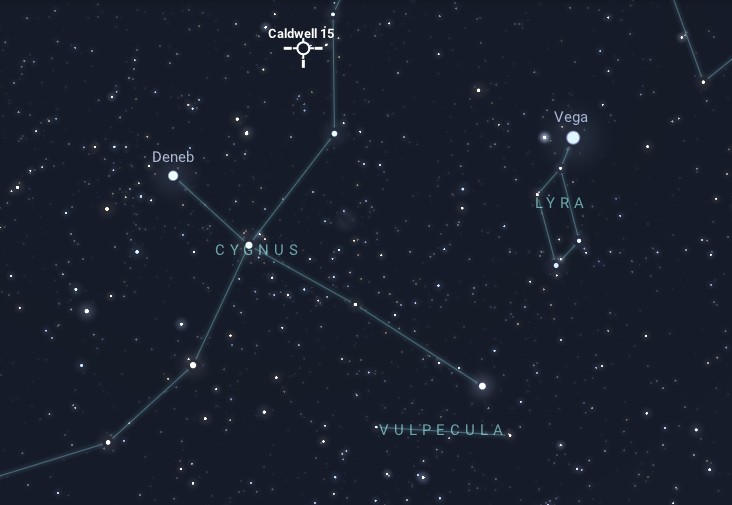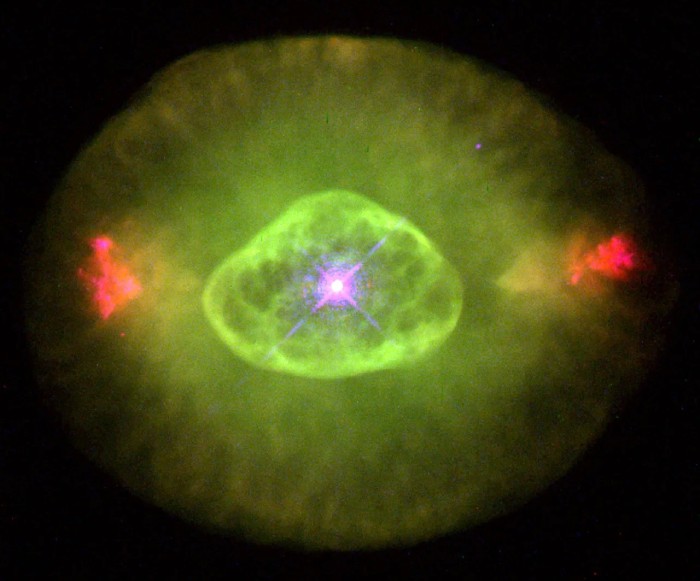NGC 6826, also known as the Blinking Planetary Nebula or Caldwell 15, is a striking planetary nebula located in the constellation Cygnus, the Swan. It was discovered by the German-born British astronomer William Herschel in 1787. This nebula is one of the more famous planetary nebulae due to its unique visual effect when observed through a telescope, which gives the illusion of “blinking.”
Physical Characteristics
NGC 6826 is located about 2,200 light-years away from Earth. The central star of the nebula is a white dwarf, which is the remnant core of a star that has exhausted its nuclear fuel and shed its outer layers. This white dwarf has a surface temperature of around 60,000 K and is responsible for illuminating the surrounding nebula by emitting intense ultraviolet radiation that excites the gas in the nebula, causing it to glow.
The nebula spans about 27 arcseconds in the night sky, making it relatively small, but it is bright enough to be observed with modest amateur telescopes. The visual magnitude of the nebula is around 8.8, meaning it is within reach of small telescopes and even binoculars under dark-sky conditions.
NGC 6826 is particularly famous for its “blinking” effect. When viewed through a telescope, the nebula appears to alternate between being visible and disappearing as the observer shifts their gaze. This phenomenon is caused by the way our eyes focus light differently when looking directly at the central star compared to looking at the surrounding nebula. The central star is very bright, and when viewed directly, it overwhelms the fainter nebulous regions. When the gaze is shifted slightly, the nebulous gas appears more prominently. This gives the illusion that the nebula is blinking in and out of view.
The structure of the nebula includes two bright lobes of gas extending from either side of the central star, along with faint outer shells of gas. These lobes, or polar outflows, are common in planetary nebulae and result from the star ejecting material in a non-uniform manner. The complex structure of the nebula is shaped by the central star’s intense stellar winds and interactions with the surrounding interstellar medium.
Evolutionary Stage
NGC 6826 represents the final stages of stellar evolution for stars with masses similar to the Sun. Stars like this spend the majority of their lives fusing hydrogen into helium in their cores. Once the hydrogen supply is depleted, the star expands into a red giant, where nuclear fusion occurs in outer layers around the core. During this phase, the star begins to lose its outer layers through intense stellar winds.
Eventually, the core of the star, now exposed, becomes a white dwarf—a small, hot remnant no longer undergoing nuclear fusion. The expelled outer layers form the nebula we observe, made up of glowing shells of ionized gas. The ultraviolet radiation emitted by the hot white dwarf excites the surrounding gas, causing it to emit light, which is what makes the planetary nebulae visible.
NGC 6826 displays this typical formation process, with the nebula composed of the ejected material from the dying star. Over time, the nebula will continue to expand and disperse into the interstellar medium, eventually fading away as the white dwarf cools. The material expelled in this process enriches space with elements like carbon, nitrogen, and oxygen, which contribute to the formation of new stars and planetary systems.
This phase marks the culmination of the star’s life cycle, with the nebula serving as a temporary, but striking, testament to the complex processes of stellar evolution. The nebula itself will exist for tens of thousands of years before it fully disperses, while the white dwarf will continue to cool for billions of years, eventually becoming a cold, dark object.
Observation
NGC 6826 is a popular target for amateur astronomers due to its brightness, small size, and unique blinking effect. It can be observed with small to medium-sized telescopes and even binoculars under ideal conditions. For better contrast and detail, observers often use narrowband filters, such as an OIII filter (which highlights the doubly ionized oxygen emission lines), as this enhances the visibility of the nebula’s structure while reducing interference from background light.
The nebula is best observed during the summer months in the Northern Hemisphere, from June to August, when the constellation Cygnus is high in the sky. During this time, the nebula is well-placed for evening observation, especially in dark-sky locations. For optimal viewing, it is essential to observe under clear, moonless nights and away from light pollution, as faint deep-sky objects can be very difficult to see in light-polluted areas.




